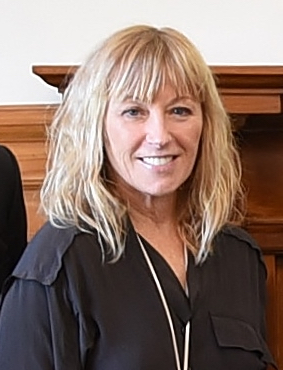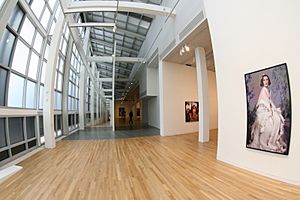Cindy Sherman facts for kids
Quick facts for kids
Cindy Sherman
|
|
|---|---|

Sherman in 2016
|
|
| Born |
Cynthia Morris Sherman
January 19, 1954 Glen Ridge, New Jersey, U.S.
|
| Education | State University of New York (SUNY) at Buffalo |
| Known for | Photographic self-portraits |
|
Notable work
|
Untitled #96, Untitled #153, Complete Untitled Film Stills, 1977–1980 |
| Spouse(s) |
Michel Auder
(m. 1984; div. 1999) |
| Awards |
|
Cynthia "Cindy" Morris Sherman (born January 19, 1954) is an American artist. She is famous for her photographic self-portraits. In her pictures, she dresses up as many different imagined characters.
Sherman became well-known for her collection Untitled Film Stills. This is a series of 70 black-and-white photos. In them, she pretends to be different types of female characters you might see in old movies.
Contents
Early Life and Education
Sherman was born in Glen Ridge, New Jersey, and grew up in Huntington, Long Island. She was the youngest of five children. Her father was an engineer, and her mother was a reading teacher.
In 1972, Sherman went to Buffalo State University to study art. At first, she focused on painting. She started dressing up in different costumes from thrift stores for fun. She soon felt that painting had too many limits. She decided to switch to photography.
"There was nothing more to say [through painting]," she later said. "I realized I could just use a camera and put my time into an idea instead."
At college, she met other artists like Robert Longo. In 1974, they started an art center called Hallwalls. Sherman was also inspired by the conceptual art she saw in galleries. Conceptual art is where the idea behind the artwork is more important than the object itself. She graduated in 1976.
Photography Career
Sherman creates her art in series, which are groups of photos with a similar theme. She works alone in her studio. She acts as the director, makeup artist, hairstylist, and model for all of her pictures.
Early Work
One of Sherman's first projects was Bus Riders (1976). She took photos of herself dressed as different characters you might see on a bus. She used makeup and costumes to change her appearance for each photo. Some of these photos used makeup to change her race, which has been criticized as insensitive.
Her most famous early work is the Untitled Film Stills (1977–1980). This series made her famous around the world.
What are the Untitled Film Stills?

The Untitled Film Stills are a series of 69 black-and-white photos. In each one, Sherman poses as a different female character. The photos look like they could be from old movies from the 1940s, 50s, and 60s. The characters include librarians, housewives, and movie stars.
Sherman did not give the photos titles. This was to keep people guessing about the story behind each image. The women in the photos are often shown alone and with blank expressions. The photos make you think about how women are often shown in movies and media.
In 1995, the Museum of Modern Art in New York City bought the entire series for about $1 million.
Art in the 1980s
In the 1980s, Sherman started using color photography and making much larger prints.
- Centerfolds (1981): This series was inspired by photos in the middle of magazines. Sherman posed on the floor or in bed. She wanted to challenge what people expected to see in these kinds of pictures.
- Fairy Tales (1985) and Disasters (1986–1989): In these series, Sherman used fake body parts and mannequins to create strange and unsettling images. The characters were not like the ones in classic fairy tales. They were often dark and disturbing.
- History Portraits (1989–1990): For this series, Sherman recreated famous European portrait paintings from the 15th to 19th centuries. She dressed up as the subjects of these old paintings.
Later Photography
Sherman continued to explore new ideas in her work.
- Society Portraits (2008): In this series, Sherman dressed up as wealthy, aging women. The photos explore ideas about beauty, aging, and social status. She used digital editing to add wrinkles and other signs of aging.
- Clowns (2003–2004): She used digital photography to create colorful and sometimes scary pictures of herself as a clown.
- Chanel Series (2012): She created large-scale photos for a magazine. In them, she posed as mysterious female figures in front of dramatic landscapes she had photographed in Iceland and Italy.
- Instagram Art: Sherman uses social media, especially Instagram, to create and share her work. She uses many photo-editing apps to change her appearance in her selfies.
Work in Fashion
Sherman has also worked with famous fashion brands.
- In 1983, she created ads for the store Dianne B.
- She has created photos for magazines like Harper's Bazaar.
- She has worked with designers like Marc Jacobs, Comme des Garçons, and Balenciaga.
In her fashion work, she often plays with the typical style of fashion photography. Instead of just showing the clothes, she creates interesting characters and stories.
Films and Music
In the early 1990s, Sherman worked with the band Babes in Toyland. She took photos for their album covers and helped create a stage backdrop for their concerts.
In 1997, she directed a movie called Office Killer. The film is a dark comedy about a quiet office worker who starts causing trouble. The movie received mixed reviews from critics. Sherman has also appeared in small roles in other films.
Why is Her Work Important?
Many people see Sherman's work as feminist. Her photos explore how women are seen by society. They question stereotypes and ideas about female identity. By dressing up as so many different characters, Sherman shows that "femininity" can be like a costume that people put on.
When asked about it, Sherman said she hopes her work is seen as feminist, but she doesn't like to talk about theories. She wants the pictures to speak for themselves.
Her work has influenced many other artists. Photographers like Ryan Trecartin and artists like James Franco have been inspired by her ideas about identity and self-portraits.
Personal Life
From 1974 to 1980, Sherman was in a relationship with artist Robert Longo. She married French director Michel Auder in 1984, and they divorced in 1999. From 2007 to 2011, she was in a relationship with musician David Byrne.
Sherman lives and works in New York. She has a home and studio in New York City and also owns property in East Hampton, New York.
Awards and Recognition
Cindy Sherman has received many awards for her art.
- 1995: MacArthur Fellowship, often called a "genius grant."
- 1999: Hasselblad Award, a major international award in photography.
- 2012: Roswitha Haftmann Prize, a European art prize.
- 2020: Wolf Prize in Art.
- 2024: Golden Plate Award from the American Academy of Achievement.
Her work is in major museum collections around the world, including the Museum of Modern Art in New York and the Tate Modern in London.
See also
 In Spanish: Cindy Sherman para niños
In Spanish: Cindy Sherman para niños
- Self-portraiture
- Blackface in contemporary art
- Laurel Nakadate
- List of most expensive photographs
- Nikki S. Lee

